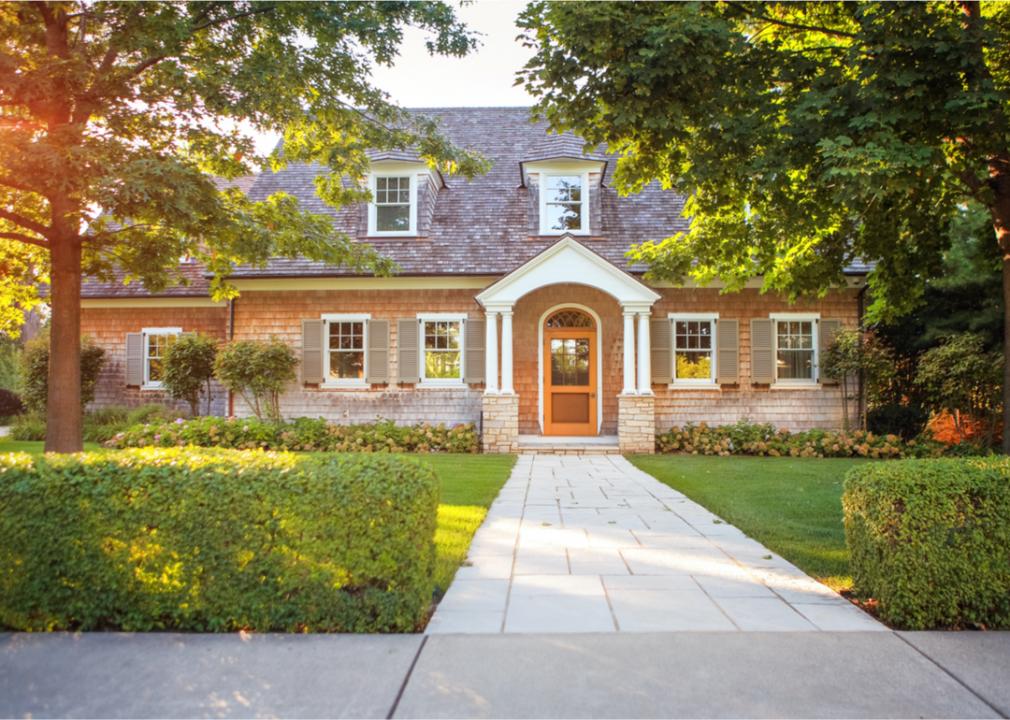How real estate wealth compares across generations

wavebreakmedia // Shutterstock
How real estate wealth compares across generations
Many financial experts believe that when it comes to accumulating and growing wealth, a large portion of one’s portfolio should be in real estate as part of an overall wealth-building plan. Experts say between 25-40% of your net worth should be in real estate because that asset class allows investors to capitalize on the benefits of real estate ownership—like passive income, equity, and appreciation—as you pursue other methods of investment and wealth development.
Investing in real estate to build wealth is hardly a new concept. Real estate ownership has always been a significant driver of wealth and can be traced back to before the Revolutionary War, when property ownership was a symbol of wealth and one of the primary ways for the wealthy to secure assets. Not much has changed since then. Real estate investing remains a primary vehicle for gaining wealth and growing assets, a trend that is likely to continue for many more generations to come. What will change, however, is how the real estate wealth compares across generations.
The real estate referral site UpNest recently examined household wealth by generation using Federal Reserve data that goes back to 1989. This data compares real estate wealth between the silent generation (born before 1946), the baby boomers (born between 1946 and 1964), Gen X (born between 1965 and 1980), and millennials (born between 1981 and 1996). The results were surprising. Real estate wealth trends among generations evolve as much as fashion, music, and culture on a yearly basis. Check out the slides below to find out more about how real estate wealth has compared across generations over the last three decades.
![]()

TierneyMJ // Shutterstock
1989
Share of real estate wealth:
– Silent and earlier: 67%
– Baby boomer: 32.3%
– Gen X: 0.7%
In 1989, President Ronald Reagan had just exited office and the newly elected President George Bush had stepped in as the 41st president of the United States. It was a pivotal point in global politics, and it was also an excellent year to be a member of the silent generation or earlier, at least when it came to real estate wealth. The median home price in 1989 was about $120,425, and the silent or earlier generations (who were born before 1946), held the largest share of real estate wealth, likely due to having more disposable income after decades in the workforce. The baby boomers, who would have been in their mid-30s to late-40s, captured less than half of the real estate wealth as their parents’ generation. The Gen X crowd only held a small fraction of the real estate wealth, likely due to members of this generation being teenagers or young adults during this time. Obviously, they did not have the time to accumulate the wealth necessary to purchase homes.

goodluz // Shutterstock
1990
Share of real estate wealth:
– Silent and earlier: 66.9%
– Baby boomer: 32.3%
– Gen X: 0.9%
In 1990, President George Bush was leading the United States into military operations in the Persian Gulf, and a recent U.S. Federal Reserve interest rate hike was taking a toll on the housing market. Median home prices hovered near $122,300 for the year, and the silent and earlier generations continued to hold the largest share of real estate wealth, while the baby boomer generation struggled to grow year-over-year. Surprisingly, the Gen X generation inched up slightly from 1989 to 1990, presumably due to more members of this generation becoming settled in their careers and having more disposable income to invest in property.

fizkes // Shutterstock
1991
Share of real estate wealth:
– Silent and earlier: 65.5%
– Baby boomer: 33.4%
– Gen X: 1.2%
The early version of the World Wide Web was released to the public in 1991, and while we didn’t know it at the time, it would have a massive impact on the way we live, work, and invest over the next several decades. The Dow topped 3,000 for the first time that year, and unemployment averaged 5.6%, two factors that pointed to a strong economy. The favorable economic conditions, and the lower median price of homes nationwide compared to the year prior, could help explain why the share of real estate wealth for Gen X and the boomer generations increased, both of which had significant jumps from the year prior. The silent and earlier generations still held the majority of the real estate wealth during this time, but the boomer and Gen X generations were clearly picking up steam.

fizkes // Shutterstock
1992
Share of real estate wealth:
– Silent and earlier: 63.5%
– Baby boomer: 34.8%
– Gen X: 1.7%
In 1992, the world was saying hello to newly elected President Bill Clinton, while waving goodbye to President George Bush’s presidency after a failed re-election campaign that was caused, in part, by a sluggish economy. The median cost of homes had decreased from previous years to about $121,375 thanks to slow economic growth, which made it easy for younger generations to invest in real estate. Despite the favorable economic conditions, the share of real estate wealth owned by the silent and earlier generations still declined by about 2% from the year prior in 1992. The baby boomer generation continued to accrue more real estate wealth, though, as did Gen X, which increased real estate wealth overall by about half a percent compared to the year prior.

YP_Studio // Shutterstock
1993
Share of real estate wealth:
– Silent and earlier: 62.1%
– Baby boomer: 35.5%
– Gen X: 2.5%
The economy was gaining strength in 1993, with unemployment rates averaging about 6.5% and inflation at about 2.99%. The minimum wage was $4.25 an hour, and the median price of homes was about $126,500 nationally, which was an increase of about $5,000 from the year prior. The jump in home prices didn’t deter the Gen X or baby boomers from investing in real estate, though. Both generations increased their share of real estate wealth in 1993. On the other hand, the real estate wealth share for the silent and earlier generations continued to slide downhill, likely due to an aging population and their need to downsize.

Canva
1994
Share of real estate wealth:
– Silent and earlier: 60.1%
– Baby boomer: 36.6%
– Gen X: 3.2%
In 1994, the economy was starting to surge under President Clinton. This year would bring a 3% economic growth rate, a whopping two million new jobs, and an inflation rate reminiscent of the 1960s—as well as rising home prices. The median home had a price tag of about $130,425, and the Gen X and baby boomers continued on their missions to grow their shares of real estate wealth. The silent and earlier generations continued to divest or downsize compared to younger generations, a trend that would continue for years to come.

Canva
1995
Share of real estate wealth:
– Silent and earlier: 55.7%
– Baby boomer: 40.1%
– Gen X: 4.2%
The economy was still going strong in 1995, with unemployment hovering around 5.6% and inflation averaging just 2.83%. This year, O.J. Simpson’s trial would end with an acquittal, Microsoft would release its Windows 95 program, a 19-year-old named Tiger Woods would win the U.S. Amateur Championship, and the median price of homes grew again to about $133,475. The Gen X share of real estate wealth grew a full point from the year prior, and the baby boomers’ share of real estate wealth increased by a whopping 3.5% from 1994 to 1995. On the other hand, the silent and earlier generations’ shares of real estate wealth dropped significantly as the population continued to age.

Freedomz // Shutterstock
1996
Share of real estate wealth:
– Silent and earlier: 53.4%
– Baby boomer: 41.5%
– Gen X: 5.2%
The U.S. stock markets were going strong in 1994, with the Dow Jones Industrial Average gaining at an incredibly fast pace and ending the year over the 6,000 mark. Home prices were also strong, jumping to a median of $140,250 nationwide, and the two younger generations—baby boomers and Gen X—continued to chip away at their fair share of real estate wealth in the favorable economy. Gen X increased their share by a full point for a second year in a row, and baby boomers added another 1.4% in real estate wealth to the mix. The silent and earlier generations, which would have been in retirement and less likely to capitalize on favorable employment conditions in 1996, dropped about 2.3% of their real estate wealth year-over-year.

tokar // Shutterstock
1997
Share of real estate wealth:
– Silent and earlier: 52.3%
– Baby boomer: 41.6%
– Gen X: 6.2%
Short-lived economic trouble hit in 1997 when the stock market had a “flash crash” and recovery, dropping 7.18% before recovering by about 4.71% the following day. The flash crash had no impact on housing prices, though, with the median home price nationwide growing by about $5,000 year-over-year. For the third year in a row, members of Gen X increased their share of real estate wealth by a full 1% as the younger generation continued to grow in their careers and earning potential.

Monkey Business Images // Shutterstock
1998
Share of real estate wealth:
– Silent and earlier: 50.3%
– Baby boomer: 42.3%
– Gen X: 7.4%
In 1998, trouble was brewing in the U.S. political landscape, with President Bill Clinton’s denials of a relationship with intern Monica Lewinsky leading to his impeachment. There was also trouble brewing for the housing market due lenders issuing an abundance of subprime mortgages, which were being offered to less-than-qualified buyers at a rapid pace. The ease with which mortgages could be acquired caused the housing market to hit a milestone. Prices shot above $150,000 for the first time ever. With a minimum wage of $5.15, a median household income of $38,568.00, and the median price of homes at $151,925, the economy was strong, and Gen X continued to grow their share of real estate wealth, adding another 1.4% to the mix.

insta_photos // Shutterstock
1999
Share of real estate wealth:
– Silent and earlier: 47.6%
– Baby boomer: 43.8%
– Gen X: 8.6%
With Y2K looming, the year 1999 came with a lot of unknowns. Luckily, early planning for possible tech issues kept any major problems at bay and allowed a new millennium to be ushered in without catastrophe. It wasn’t just the end of a millennia, though; it was also the first time since 1989 that the silent and earlier generations’ shares of real estate wealth dropped below 50%—marking a significant shift in which generations were capitalizing on real estate investing. Home prices also saw a notable shift, with median prices hitting $160,125, a significant increase from the year prior. The Gen X share of real estate wealth increased by 1.2% year-over-year, and the baby boomer share of real estate wealth also increased.

wavebreakmedia // Shutterstock
2000
Share of real estate wealth:
– Silent and earlier: 45%
– Baby boomer: 45.1%
– Gen X: 9.9%
The new millennium ushered in the dot-com bubble burst, which caused a massive downturn in stock prices and led to years of subsequent stock market problems. Home prices were spared, though, with the nationwide prices increasing significantly to land at a median price of $167,550. The percentage of real estate wealth held by Gen X also increased, as did the baby boomer real estate wealth share, as more people looked for safer investment opportunities. This launched the baby boomers to the top spot for real estate wealth, while the aging silent and earlier generations continued to divest as compared to the younger generations.

Monster Ztudio // Shutterstock
2001
Share of real estate wealth:
– Silent and earlier: 43.2%
– Baby boomer: 45.7%
– Gen X: 11.1%
– Millennial: 0.1%
The year 2001 was a rough one for the entire nation. The stock market continued to unravel, and the subsequent recession, which lasted from March to November, caused even more strife—as did the 9/11 attacks. Despite the economic troubles, the U.S. housing market remained strong, with a median home price of about $173,100, and the growth of Gen X’s share of real estate wealth also remained strong. The millennial generation also entered the equation and began to carve out a small share of real estate wealth as more members of this generation accrued enough earning potential to invest in property.

Inna Dodor // Shutterstock
2002
Share of real estate wealth:
– Silent and earlier: 41.1%
– Baby boomer: 46.2%
– Gen X: 12.5%
– Millennial: 0.2%
The stock market woes finally ended in 2002 after a total drop of 49.1% in the S&P 500 index. But, while the stock market recovered, other economic troubles loomed, and this included the bankruptcy of multiple airlines over the course of the year. Surprisingly, these economic challenges had no impact on housing prices, which hit a median price of $186,025 in 2002. The Gen X, baby boomer, and millennial generations all increased their shares of real estate wealth from 2001 to 2002, but the drop in real estate wealth for silent and earlier generations continued.

Tijana Moraca // Shutterstock
2003
Share of real estate wealth:
– Silent and earlier: 39.3%
– Baby boomer: 46.8%
– Gen X: 13.6%
– Millennial: 0.3%
In 2003, President George W. Bush signed the third-largest tax cut package in U.S. history into law, which greatly reduced the top four marginal income tax rates and the tax rate on capital gains and dividends. The average home value in the U.S. also crept higher, landing at a median price of $192,125. The higher average home price didn’t do much to deter Gen X, baby boomers, or millennials from buying real estate, though. All three generations increased their shares of real estate wealth in 2003, while the silent and earlier generations dropped below 40% of shares for the first time ever.

Arina P Habich // Shutterstock
2004
Share of real estate wealth:
– Silent and earlier: 37.2%
– Baby boomer: 47.4%
– Gen X: 15.2%
– Millennial: 0.4%
The year 2004 was a banner year for home prices. Not only did the U.S. median home price rise above $200,000 for the first time in history, but the median price of $218,150 meant home prices were significantly more expensive in 2004 than 2003. The uptick in price didn’t put a damper on the upward trajectory in real estate wealth that Gen X, the baby boomers, or the millennials were seeing during this time, however. All three generations had at least marginal increases in their real estate wealth shares compared to the year prior, as these generations continued to work and build their careers.

godshutter // Shutterstock
2005
Share of real estate wealth:
– Silent and earlier: 35.4%
– Baby boomer: 46.5%
– Gen X: 17.7%
– Millennial: 0.5%
The housing market continued to a screeching halt in many formerly strong markets across the United States in late summer 2006—one of the first indicators that trouble was on the horizon. Ballooning inventories caused by overdevelopment and sharply reduced sales volumes caused cracks in the housing market facade, though the worst of the housing crisis was yet to come. Still, home prices continued to rise to a median of $236,550 due in part to the abundance of subprime mortgages, as did the shares of real estate wealth for millennials and Gen X, with Gen X gaining an astounding 2.5% from 2004 to 2005. The baby boomer generation, on the other hand, saw the first drop in real estate wealth in several years as they moved further into their retirement years.

Amnaj Khetsamtip // Shutterstock
2006
Share of real estate wealth:
– Silent and earlier: 33.3%
– Baby boomer: 46.3%
– Gen X: 19.7%
– Millennial: 0.7%
The stock market was booming in 2006, as was the economy overall, with the The Dow Jones Industrial Average closing above 12,000 for the first time in its 110-year history. Unemployment rates were low, inflation was just 3.23%, and housing prices were also booming, hitting a median price of $243,750 nationwide, despite subprime lending practices causing fissures in the housing market that would later lead to disaster. Gen X continued to make gains, as did the millennials.

Onchira Wongsiri // Shutterstock
2007
Share of real estate wealth:
– Silent and earlier: 31.8%
– Baby boomer: 46.4%
– Gen X: 21%
– Millennial: 1%
In 2007, President George W. Bush signed the Fair Minimum Wage Act of 2007 into law, the Dow Jones Industrial Average closed at an all-time high of 14,164.53, and the median housing prices also hit a high of $244,950. But, while numerous economic milestones were met, the share of real estate wealth held by silent and earlier generations hit an all-time low. On the other hand, the share of real estate wealth held by Gen X, the baby boomer generation, and millennials increased across the board, due at least in part to the favorable market conditions.

Suzanne Tucker // Shutterstock
2008
Share of real estate wealth:
– Silent and earlier: 30.3%
– Baby boomer: 47.4%
– Gen X: 21%
– Millennial: 1.4%
The year 2008 was hardly a great year for the U.S. economy, which was facing the worst financial crisis since the Great Depression. The mortgage market collapsed thanks to out-of-control subprime lending practices, the Dow Jones Industrial Average lost 33.8% of its value, and the U.S. labor market lost 8.4 million jobs during this time. Property prices fell across the nation to a median of $229,550, and consumer spending took a downturn, too. As a result, the growth of real estate wealth stagnated for Gen X and the silent and earlier generations.

Cyber Kristiyan // Shutterstock
2009
Share of real estate wealth:
– Silent and earlier: 28.8%
– Baby boomer: 48.4%
– Gen X: 20.9%
– Millennial: 1.9%
The economic hardships caused by the subprime lending crisis continued into 2009, well after President Barack Obama was sworn into office. Home prices remained low across the nation, dropping to a median of $215,650, and consumer spending remained stagnant as well. What did not remain stagnant, however, was the share of real estate wealth for the baby boomer generation. Despite the decline in real estate wealth that occurred a few years prior, baby boomers managed to capitalize on lower prices and interest rates, while Gen X, which was hit hard by the poor economic conditions, lost a fraction of the real estate wealth.

Dean Drobot // Shutterstock
2010
Share of real estate wealth:
– Silent and earlier: 28.3%
– Baby boomer: 49.1%
– Gen X: 20.4%
– Millennial: 2.3%
While the economy had started to recover by 2010, not everything was back on track. Unemployment was at about 9.5% for the year, which was significantly higher than it had been in the years prior to the subprime lending crisis and the subsequent economic collapse. Median house prices remained low, increasing to just $222,700 nationwide. The share of real estate wealth continued to decline for Gen X, which sustained one of the hardest hits by the economic downturn. Millennials and baby boomers saw a significant uptick in real estate wealth shares.

Rido // Shutterstock
2011
Share of real estate wealth:
– Silent and earlier: 27.2%
– Baby boomer: 48.9%
– Gen X: 21.2%
– Millennial: 2.8%
The economy remained weak in 2011, with an unemployment rate of 9.1% and a median home price of $224,900, which was lower than it had been prior to the subprime mortgage crisis. But, as the nation continued to struggle to recover from the 2008 housing market crash, Gen X capitalized on the opportunity to invest in less expensive real estate, growing their share of real estate wealth significantly during this time.

G-Stock Studio // Shutterstock
2012
Share of real estate wealth:
– Silent and earlier: 25.4%
– Baby boomer: 48%
– Gen X: 23.1%
– Millennial: 3.5%
In 2012, Barack Obama was re-elected president of the United States, defeating Republican opponent Mitt Romney by a significant margin. The economy also had a win thanks to the Obama administration cutting over $200 billion in payroll taxes for about 160 million working Americans in 2011-12, which helped to stimulate the economy. Gen X and millennials also continued to prevail in real estate wealth growth, a trend that continued as members of these generations carved out their career paths in this more favorable economic time.

scarp577 // Shutterstock
2013
Share of real estate wealth:
– Silent and earlier: 24.3%
– Baby boomer: 47.1%
– Gen X: 24.7%
– Millennial: 3.9%
Home prices rebounded by over 11% in 2013 while the unemployment rate dropped, two signs that the economic recovery remained on track despite the challenges, which included a partial shutdown of the United States government, the first in 17 years. The growth of real estate wealth for Gen X and millennials continued to grow during this year as the working generations seized opportunities to invest in property and prices were lower than they had been in years prior.

NAN728 // Shutterstock
2014
Share of real estate wealth:
– Silent and earlier: 23.5%
– Baby boomer: 46.4%
– Gen X: 25.3%
– Millennial: 4.9%
All signs pointed to a strong economy in 2014, with unemployment rates dipping to just 5.6% and the median cost of homes skyrocketing to $285,775, which was a significant increase from the years prior. What did not increase, however, was the share of the baby boomer or silent generations’ real estate wealth. Still, Gen X continued the upward trajectory, and millennials also increased their share of real estate wealth in 2014, which followed the trend of younger generations capturing more shares of real estate wealth each year.

GaudiLab // Shutterstock
2015
Share of real estate wealth:
– Silent and earlier: 22.7%
– Baby boomer: 45.6%
– Gen X: 25.6%
– Millennial: 6.1%
The year 2015 was a turning point for income equality in America, with the share of Americans living in middle-income households falling below 51% for the first time in four decades. But despite the less-than-optimal income equality statistics, the economy was strong, with unemployment dipping and the median cost of homes increasing to $294,150. In turn, every generation except for the silent and earlier generations grew their shares of real estate wealth in 2015. Millennials, many of whom would have been a few years into the workforce at this point, saw the highest increase.

Jacob L // Shutterstock
2016
Share of real estate wealth:
– Silent and earlier: 21.7%
– Baby boomer: 45.3%
– Gen X: 25.9%
– Millennial: 7.2%
Between a divisive presidential election, Russian hacking allegations, Brexit, Zika virus, and other global events, the year 2016 was a contentious one. The divided political landscape didn’t stop millennials from grabbing their fair share of real estate wealth that year, though. While the other generations remained stagnant or declined in property wealth, millennials actually increased their share of real estate wealth by 1.1%—which is no small feat, considering that the median home price in December 2016 was $305,125, much higher than it had been in the years prior. A continuation of low interest rates kept borrowing cheap and made entry into the real estate market more affordable.

Africa Studio // Shutterstock
2017
Share of real estate wealth:
– Silent and earlier: 19.7%
– Baby boomer: 44.9%
– Gen X: 27.2%
– Millennial: 8.3%
In 2017—10 years after the Great Recession started—the global economic growth was rapidly accelerating while stock markets across the globe and median home prices were hitting record highs, all of which happened in spite of a precarious political landscape. The thriving economy helped Gen X and millennials to increase their shares of real estate wealth. The baby boomers and silent and earlier generations decreased a significant portion of their real estate wealth from 2016 to 2017.

Impact Photography // Shutterstock
2018
Share of real estate wealth:
– Silent and earlier: 17.3%
– Baby boomer: 44.4%
– Gen X: 28.7%
– Millennial: 9.5%
The year 2018 was a strong one for the U.S. economy, with the stock market hitting record highs early in the year and the U.S. unemployment rates hitting 3.7% in late fall, a 49-year low. The stock market momentum continued throughout 2018, with the stock market hitting a record highs a total of 15 times that year. The thriving economy helped fuel the growth of the Gen X or millennial real estate wealth shares—and helped increase the median price for a home to a high of $325,275.

tsyhun // Shutterstock
2019
Share of real estate wealth:
– Silent and earlier: 15.1%
– Baby boomer: 43.7%
– Gen X: 30.2%
– Millennial: 11%
The U.S. government also entered into a trade war with China in 2019, and ongoing barriers caused by the global trade standstill led to both uncertainty for businesses and a sluggish economic growth pace overall. This led to a drop in median home prices nationwide, which hovered around $320,250 for the year. The lower home prices likely helped to lessen some of the financial barriers Gen X and millennials faced with buying real estate, and allowed these two generations to carve out more real estate wealth year-over-year.

fizkes // Shutterstock
2020
Share of real estate wealth:
– Silent and earlier: 14.1%
– Baby boomer: 44.2%
– Gen X: 30.7%
– Millennial: 10.9%
The year 2020 brought with it a new president, a global pandemic, and nationwide protests over racial injustices—as well as extremely low mortgage rates to help stimulate a sluggish economy. Pandemic-related restrictions led Americans to stay home more, and that, coupled with the record-low borrowing rates, caused interest in real estate to skyrocket. The median home price increased to $336,950, the highest it’s ever been. And, for the first time in years, the baby boomer generation managed to capture more property wealth year-over-year, adding another 0.5% to the generation’s share of real estate wealth. Gen X also added another 0.5% to their real estate wealth, while millennials struggled to keep up with the growth they’d seen in years prior.
This story originally appeared on UpNest and was produced and distributed in partnership with Stacker Studio.